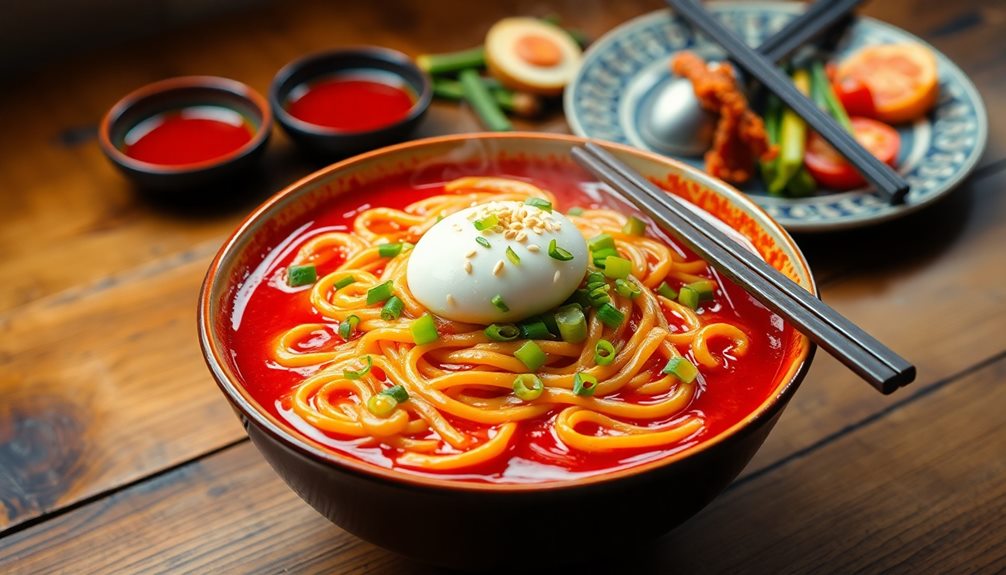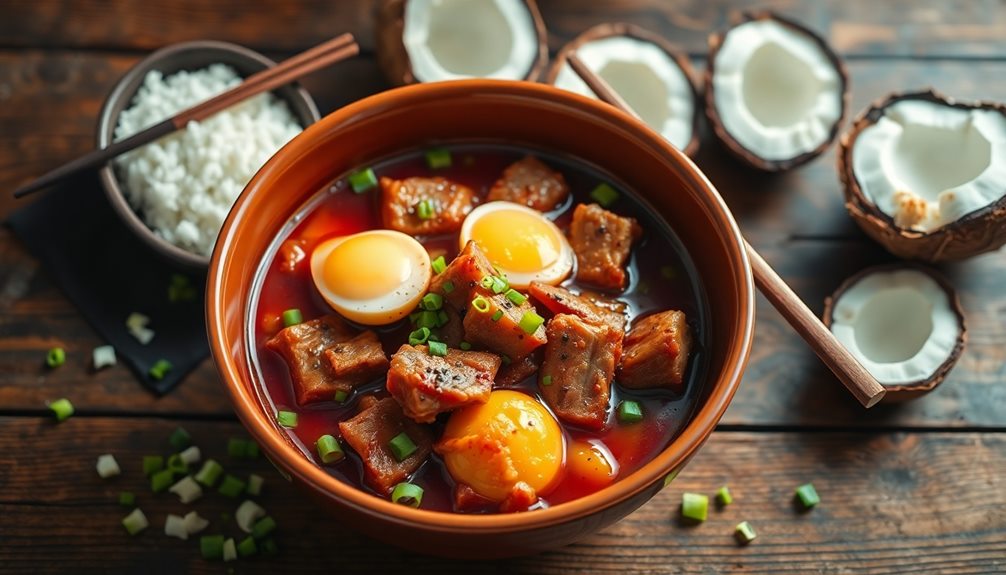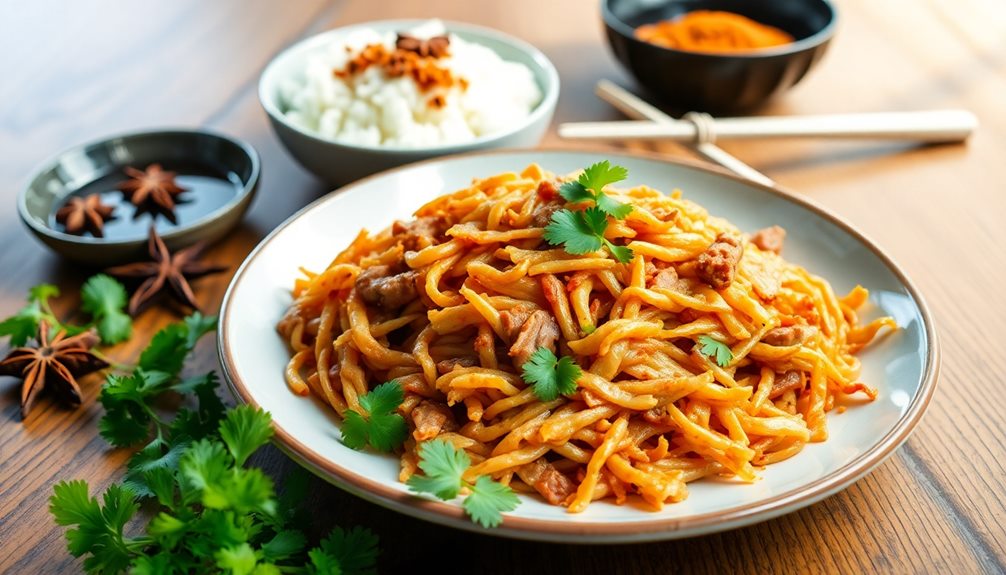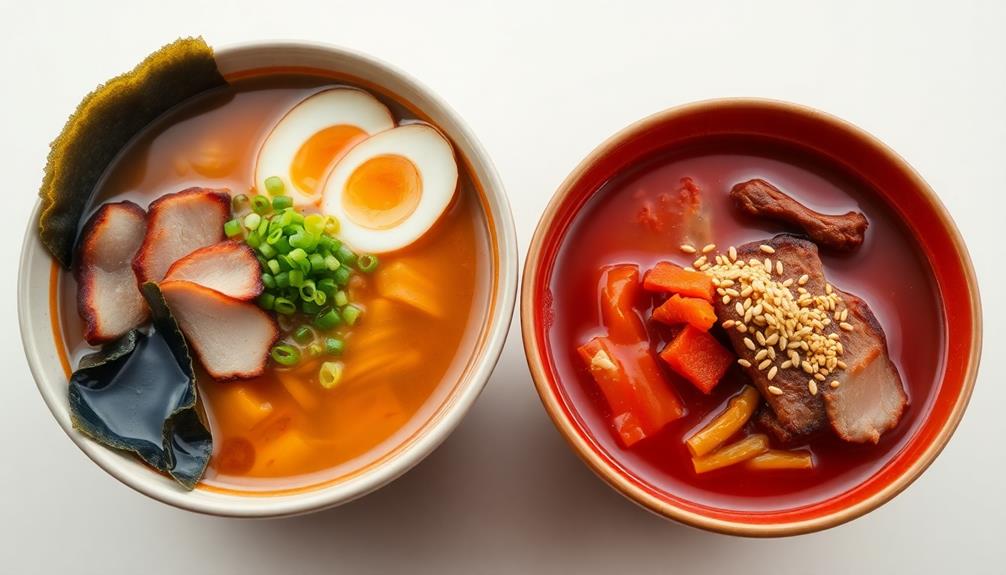Ramen and ramyun might look similar, but they're different noodle stars! Ramen, which comes from Japan, is usually rich and comforting with fresh ingredients. It often takes a bit more time to prepare, focusing on that delicious broth. Ramyun, created in Korea, is spicier and super quick to cook. It's perfect for when you need a tasty meal fast! Just add water, cook the noodles, and add that seasoning packet. Both dishes have their unique charm, making them favorites around the world! Keep exploring to discover even more about these noodle treasures!
Key Takeaways
- Ramen originated in Japan, evolving from Chinese noodles, while Ramyun is a Korean adaptation influenced by ramen with a spicier profile.
- Ramen features fresh, handmade noodles and rich, flavorful broths, whereas Ramyun typically uses instant noodles with a seasoning packet.
- Cooking ramen is a more involved process, often including various toppings, while ramyun is quick and convenient, ideal for fast meals.
- Ramen emphasizes complex flavors and textures, while ramyun offers bold, straightforward tastes and is often spicier, appealing to diverse palates.
- Both dishes reflect cultural adaptations and global popularity, catering to different dining experiences—ramen for comfort and ramyun for speed.
History
When you dive into the history of ramen and ramyun, you'll uncover a fascinating evolution that reflects cultural exchanges between Japan and Korea. Ramen, which originated in China, made its way to Japan in the late 1800s. Japanese people quickly embraced this delicious noodle dish, adding their own unique flavors and ingredients.
You'd be amazed at how ramen transformed over the years, becoming a beloved comfort food throughout Japan.
On the other hand, ramyun found its roots in Korea, influenced by Japanese ramen but with its own special twist. After the Korean War, ramyun became popular as a quick and easy meal, perfect for busy families.
It's often spicier than ramen, featuring bold flavors and toppings like kimchi and vegetables.
Both dishes tell stories of adaptation, creativity, and the blending of cultures. Today, you can find ramen and ramyun all over the world, each dish offering something special to enjoy.
Whether you prefer the warm, savory broth of ramen or the spicy kick of ramyun, both have rich histories that connect people through their love of noodles.
Cooking Steps
While the ingredients for ramen and ramyun may seem similar, the cooking steps differ significantly, making each dish unique.
When you cook ramen, you start by boiling water and adding fresh, handmade noodles. You'll let them cook for about three to five minutes until they're just right. Meanwhile, prepare your broth on the side! This could be a delicious pork, chicken, or vegetarian broth. Once the noodles are ready, you'll drain them and place them in a bowl, pouring the rich broth over the top.
Now, let's talk about ramyun! You'll also start with boiling water, but this time, you'll toss in the instant noodles. They cook super fast, usually in just three to four minutes. After cooking, you can add the seasoning packet that comes with it for that extra kick of flavor. If you want, you can toss in some veggies or an egg for a special treat!
Whether you're slurping up ramen or ramyun, both dishes are fun to make and taste amazing.
Step 1. Boil Water for Noodles
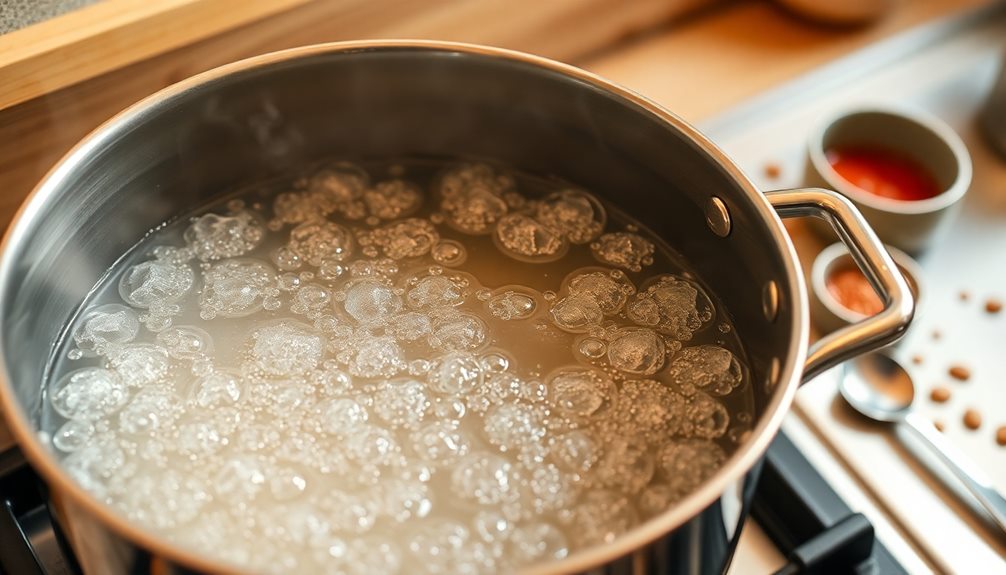
To get started on your noodle dish, bring a pot of water to a rolling boil. This step is super important because the hot water cooks your noodles evenly, making them soft and delicious.
Choose a pot that's big enough so the noodles have room to move around. If you use a smaller pot, they might stick together!
As you wait for the water to boil, you can add a pinch of salt. This'll help flavor your noodles and make them taste even better.
You'll know the water is ready when you see big bubbles popping up. It should be bubbling like a little hot spring!
Make sure to keep an eye on it, though. If you leave it unattended, it might boil over, and that can make quite the mess. Plus, the steam can be hot, so be careful if you're standing close.
Once your water is boiling, you're one step closer to enjoying a tasty bowl of ramen or ramyun.
Step 2. Add Noodles to Boiling Water
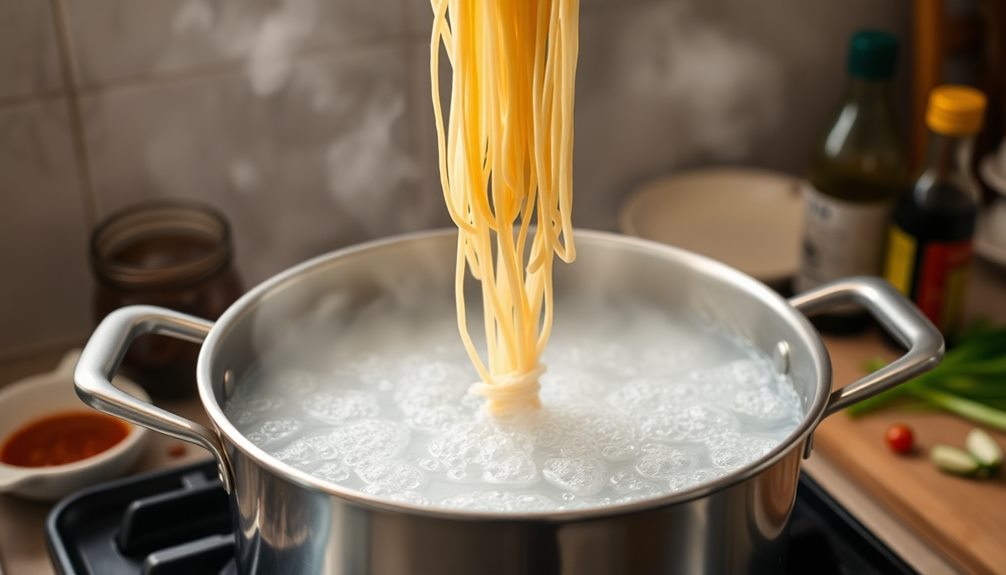
Now that your water's bubbling away, it's time to add the noodles! Carefully take the pack of ramen or ramyun and open it up. If you're using instant noodles, you'll notice they're often in a block shape. Just gently place the noodles into the boiling water. Make sure to stand back a little to avoid any splashes!
As the noodles hit the water, you'll hear that satisfying sizzle. It's a sign that deliciousness is on the way! Depending on what type you're cooking, the noodles will usually take around 3 to 5 minutes to become soft and tender. You can peek at them after a couple of minutes.
While they cook, the water will start to turn slightly cloudy, and you might even catch a lovely aroma wafting up. That's a good sign!
Remember, you don't want to overcook them, so keep an eye on the timer. When the noodles are just right, they'll be perfect for whatever broth or sauce you plan to add.
Get ready for a delightful bowl of goodness that you can enjoy with friends or family! Happy cooking!
Step 3. Stir Noodles Gently
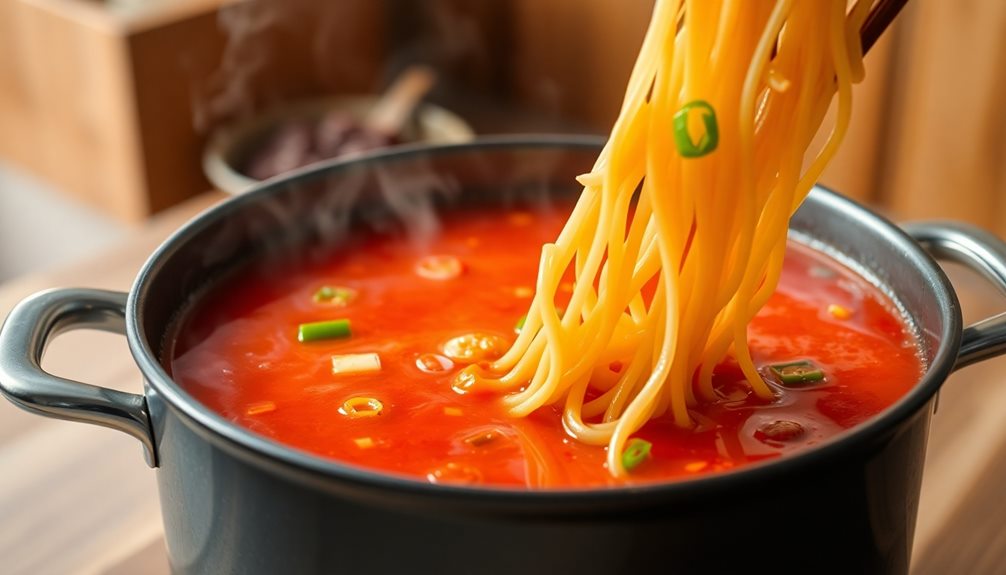
As the noodles cook, you'll want to stir them gently to prevent clumping and ensure even cooking. This step is super important! When you add those lovely noodles to the boiling water, they can stick together if you don't give them a little love.
Grab a pair of chopsticks or a fork—whatever you find easier—and carefully swirl the noodles around.
Make sure you stir them every minute or so. This way, they'll cook perfectly and won't turn into a sticky mess. You'll notice the noodles start to soften and become a bit more flexible. That's when the magic happens!
Keep an eye on the clock, too. Most ramen and ramyun noodles only need a few minutes to cook. If you stir gently and keep checking, you'll know when they're ready to be taken off the heat.
Once they're cooked just right, you can't help but get excited about the delicious meal coming up!
Step 4. Add Seasoning Packet

Pour the seasoning directly into the pot, and watch as it swirls around, mixing with the warm broth. You can already smell the amazing aroma filling the kitchen!
If you're feeling adventurous, you can even add a little extra spice or some of your favorite toppings now.
Stir the noodles gently again to make sure every strand is coated in that savory goodness. You'll notice the color of the broth changing, becoming a rich, inviting hue. This is when the noodles really start to soak up all those yummy flavors.
Don't rush this part—take a moment to enjoy the delightful smells and the colorful sight in your pot.
You're just a few steps away from a delicious bowl of ramen or ramyun! So, let's keep the excitement going as we move on to the next step!
Step 5. Simmer for Three Minutes

With the seasoning fully blended into the broth, it's time to let the flavors meld together. This is where the magic happens!
You'll want to bring your pot to a gentle simmer. If you've got the heat just right, you'll see tiny bubbles rising to the surface, and you can even hear a soft bubbling sound.
Now, set a timer for three minutes. This is the perfect amount of time for the noodles to soak up all that delicious broth. It's so exciting to watch them transform!
As they cook, give them a gentle stir every now and then to make sure they're all getting cozy in that flavorful soup.
While you wait, think about what toppings you might want to add. Maybe some green onions, a soft-boiled egg, or even some crispy seaweed?
Once the timer goes off, take a moment to admire your creation. The noodles will be perfectly tender, and the broth will smell amazing!
Now you're ready to serve up your masterpiece. Grab your chopsticks or a fork, and enjoy every delicious bite of your homemade ramen or ramyun! Pair your steaming bowl of noodles with a side of banh giay Vietnamese rice cake for a delightful fusion of textures and flavors. The soft, chewy rice cake perfectly complements the rich broth and tender toppings, creating a meal that’s both satisfying and memorable. Don’t forget to garnish with freshly chopped herbs or a squeeze of lime to elevate your dish even further!
Final Thoughts
When it comes to the world of noodles, the debate between ramen and ramyun often stirs passionate opinions. You might love the rich flavors and textures of ramen, or perhaps you enjoy the spicy kick of ramyun.
Both options have their own special qualities that make them unique. Ramen usually comes with fresh ingredients and a deep broth, while ramyun is quick, easy, and perfect for a late-night snack.
Choosing between the two really depends on your mood. If you're looking for a cozy meal, ramen can be a warm hug in a bowl. On the other hand, if you want something fast and flavorful, ramyun can hit the spot in just a few minutes.
Frequently Asked Questions
Can Ramen and Ramyun Be Interchanged in Recipes?
You can often interchange ramen and ramyun in recipes, but keep in mind their texture and flavor differences. Adjust cooking times and seasonings to suit your taste, ensuring a delicious meal regardless of which you choose.
What Are the Main Ingredients in Ramen and Ramyun?
Ramen's main ingredients include wheat noodles, broth, and toppings like meat and vegetables. Ramyun typically uses instant noodles, seasoning packets, and often includes spicier flavors. You'll enjoy exploring these unique components in each dish!
Are There Vegetarian Options for Ramen and Ramyun?
Yes, you can find vegetarian options for both ramen and ramyun. Many places offer veggie broths and toppings like mushrooms, tofu, and vegetables. Just check the menu or ask for vegetarian choices when you order.
How Do Ramen and Ramyun Differ in Flavor Profiles?
When you taste ramen, you'll notice its rich, savory broth and complex seasonings. In contrast, ramyun often features a spicier, bolder flavor profile, reflecting its Korean roots. Each offers a unique culinary experience you'll enjoy!
Which Is Healthier: Ramen or Ramyun?
When considering health, you'll find that ramyun often contains more preservatives and sodium. Ramen can be healthier if you choose fresh ingredients and control seasoning, but it's essential to check the nutrition labels for each option.
